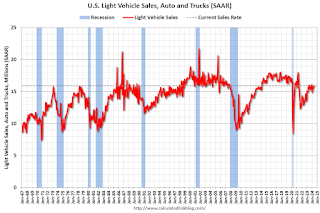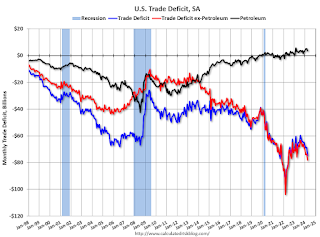by Calculated Risk on 7/01/2024 10:15:00 AM
Monday, July 01, 2024
Construction Spending Decreased 0.1% in May
From the Census Bureau reported that overall construction spending decreased:
Construction spending during May 2024 was estimated at a seasonally adjusted annual rate of $2,139.8 billion, 0.1 percent below the revised April estimate of $2,142.1 billion. The May figure is 6.4 percent above the May 2023 estimate of $2,011.8 billion.Private spending decreased and public spending increased:
emphasis added
Spending on private construction was at a seasonally adjusted annual rate of $1,652.1 billion, 0.3 percent below the revised April estimate of $1,656.7 billion. ...
In May, the estimated seasonally adjusted annual rate of public construction spending was $487.6 billion, 0.5 percent above the revised April estimate of $485.4 billion.
 Click on graph for larger image.
Click on graph for larger image.This graph shows private residential and nonresidential construction spending, and public spending, since 1993. Note: nominal dollars, not inflation adjusted.
Residential (red) spending is 6.3% below the recent peak in 2022.
Non-residential (blue) spending is 0.8% below the peak in January 2024.
Public construction spending is at a new high.
 The second graph shows the year-over-year change in construction spending.
The second graph shows the year-over-year change in construction spending.On a year-over-year basis, private residential construction spending is up 6.5%. Non-residential spending is up 4.1% year-over-year. Public spending is up 9.7% year-over-year.
ISM® Manufacturing index Decreased to 48.5% in June
by Calculated Risk on 7/01/2024 10:00:00 AM
(Posted with permission). The ISM manufacturing index indicated expansion. The PMI® was at 48.5% in June, down from 48.7% in May. The employment index was at 49.3%, down from 51.1% the previous month, and the new orders index was at 49.3%, up from 45.4%.
From ISM: Manufacturing PMI® at 48.5% June 2024 Manufacturing ISM® Report On Business®
Economic activity in the manufacturing sector contracted in June for the third consecutive month and the 19th time in the last 20 months, say the nation's supply executives in the latest Manufacturing ISM® Report On Business®.This suggests manufacturing contracted in June. This was below the consensus forecast.
The report was issued today by Timothy R. Fiore, CPSM, C.P.M., Chair of the Institute for Supply Management® (ISM®) Manufacturing Business Survey Committee:
“The Manufacturing PMI® registered 48.5 percent in June, down 0.2 percentage point from the 48.7 percent recorded in May. The overall economy continued in expansion for the 50th month after one month of contraction in April 2020. (A Manufacturing PMI® above 42.5 percent, over a period of time, generally indicates an expansion of the overall economy.) The New Orders Index remained in contraction territory, registering 49.3 percent, 3.9 percentage points higher than the 45.4 percent recorded in May. The June reading of the Production Index (48.5 percent) is 1.7 percentage points lower than May’s figure of 50.2 percent. The Prices Index registered 52.1 percent, down 4.9 percentage points compared to the reading of 57 percent in May. The Backlog of Orders Index registered 41.7 percent, down 0.7 percentage point compared to the 42.4 percent recorded in May. The Employment Index registered 49.3 percent, down 1.8 percentage points from May’s figure of 51.1 percent.
emphasis added
Housing July 1st Weekly Update: Inventory up 1.8% Week-over-week, Up 38.4% Year-over-year
by Calculated Risk on 7/01/2024 08:12:00 AM
 Click on graph for larger image.
Click on graph for larger image.This inventory graph is courtesy of Altos Research.

Sunday, June 30, 2024
Monday: ISM Mfg, Construction Spending
by Calculated Risk on 6/30/2024 07:54:00 PM
Weekend:
• Schedule for Week of June 30, 2024
• Final Look at Local Housing Markets in May and a Look Ahead to June Sales
Monday:
• At 10:00 AM ET, ISM Manufacturing Index for June. The consensus is for the ISM to be at 49.0, up from 48.7 in May.
• Also at 10:00 AM, Construction Spending for May. The consensus is for a 0.3% increase in construction spending.
From CNBC: Pre-Market Data and Bloomberg futures S&P 500 and DOW futures are up slightly (fair value).
Oil prices were mixed over the last week with WTI futures at $81.54 per barrel and Brent at $85.00 per barrel. A year ago, WTI was at $71, and Brent was at $75 - so WTI oil prices are up about 15% year-over-year.
Here is a graph from Gasbuddy.com for nationwide gasoline prices. Nationally prices are at $3.48 per gallon. A year ago, prices were at $3.50 per gallon, so gasoline prices are down $0.02 year-over-year.
Final Look at Local Housing Markets in May and a Look Ahead to June Sales
by Calculated Risk on 6/30/2024 02:05:00 PM
Today, in the Calculated Risk Real Estate Newsletter: Final Look at Local Housing Markets in May and a Look Ahead to June Sales
A brief excerpt:
In May, sales in these markets were down 0.1% YoY. In April, these same markets were up 7.6% year-over-year Not Seasonally Adjusted (NSA).There is much more in the article.
Sales in all of these markets are down compared to May 2019.
This was a 0.1% year-over-year decrease NSA for these markets. This is close to the 1.0% year-over-year decline NSA reported by the NAR reported by the NAR.
June sales will be mostly for contracts signed in April and May, and mortgage rates increased slightly to an average of 7.06% in May. My early expectation is we will see existing home sales at above the same level in June as compared to May, on a seasonally adjusted annual rate basis (SAAR).
Note for next month (June sales): There were two fewer working days in June 2024 compared to June 2023 (19 vs 21), so seasonally adjusted sales will be much higher than the NSA data suggests.
Hotels: Occupancy Rate Decreased 2.5% Year-over-year
by Calculated Risk on 6/30/2024 08:21:00 AM
The U.S. hotel industry reported lower performance results from the previous week and mixed comparisons year over year, according to CoStar’s latest data through 22 June. ...The following graph shows the seasonal pattern for the hotel occupancy rate using the four-week average.
16-22 June 2024 (percentage change from comparable week in 2023):
• Occupancy: 69.5% (-2.5%)
• Average daily rate (ADR): US$159.88 (+0.1%)
• Revenue per available room (RevPAR): US$111.17 (-2.3%)
emphasis added
 Click on graph for larger image.
Click on graph for larger image.The red line is for 2024, blue is the median, and dashed light blue is for 2023. Dashed purple is for 2018, the record year for hotel occupancy.
Saturday, June 29, 2024
Real Estate Newsletter Articles this Week: New Home Sales Decrease to 619,000 Annual Rate in May
by Calculated Risk on 6/29/2024 02:11:00 PM
At the Calculated Risk Real Estate Newsletter this week:

• New Home Sales Decrease to 619,000 Annual Rate in May
• Case-Shiller: National House Price Index Up 6.3% year-over-year in April
• Inflation Adjusted House Prices 2.3% Below Peak
• Watch Months-of-Supply!
• Freddie Mac House Price Index Increased in May; Up 5.9% Year-over-year
This is usually published 4 to 6 times a week and provides more in-depth analysis of the housing market.
Schedule for Week of June 30, 2024
by Calculated Risk on 6/29/2024 08:11:00 AM
The key report scheduled for this week is the June employment report to be released on Friday.
Other key reports include the June ISM Manufacturing survey, June Vehicle Sales and the Trade Deficit for May.
10:00 AM: ISM Manufacturing Index for June. The consensus is for the ISM to be at 49.0, up from 48.7 in May.
10:00 AM: Construction Spending for May. The consensus is for a 0.3% increase in construction spending.
9:30 AM: Discussion, Fed Chair Jerome Powell, Policy Panel Discussion, At the European Central Bank (ECB) Forum on Central Banking 2024, Sintra, Portugal
 10:00 AM ET: Job Openings and Labor Turnover Survey for May from the BLS.
10:00 AM ET: Job Openings and Labor Turnover Survey for May from the BLS. This graph shows job openings (black line), hires (dark blue), Layoff, Discharges and other (red column), and Quits (light blue column) from the JOLTS.
Jobs openings decreased in April to 8.06 million from 8.36 million in March.
The number of job openings (yellow) were down 19% year-over-year and quits were down 3% year-over-year.
 Late in the day: Light vehicle sales for June.
Late in the day: Light vehicle sales for June.The consensus is for light vehicle sales to be 15.9 million SAAR in June, unchanged from 15.9 million in May (Seasonally Adjusted Annual Rate).
This graph shows light vehicle sales since the BEA started keeping data in 1967. The dashed line is the sales rate for last month.
Wards Auto is forecasting sales of 15.9 million SAAR in June.
7:00 AM ET: The Mortgage Bankers Association (MBA) will release the results for the mortgage purchase applications index.
8:15 AM: The ADP Employment Report for June. This report is for private payrolls only (no government). The consensus is for 170,000 payroll jobs added in June, up from 152,000 in May.
8:30 AM: The initial weekly unemployment claims report will be released. The consensus is for 228 thousand initial claims, down from 233 thousand last week.
 8:30 AM: Trade Balance report for May from the Census Bureau.
8:30 AM: Trade Balance report for May from the Census Bureau. This graph shows the U.S. trade deficit, with and without petroleum, through the most recent report. The blue line is the total deficit, and the black line is the petroleum deficit, and the red line is the trade deficit ex-petroleum products.
The consensus is the trade deficit to be $72.2 billion. The U.S. trade deficit was at $74.6 billion the previous month.
10:00 AM: the ISM Services Index for June. The consensus is for a reading of 52.5, down from 53.8.
2:00 PM: FOMC Minutes, Meeting of June 11-12, 2024
US markets will close at 1:00 PM ET prior to the Independence Day Holiday.
All US markets will be closed in observance of Independence Day
 8:30 AM: Employment Report for June. The consensus is for 180,000 jobs added, and for the unemployment rate to be unchanged at 4.0%.
8:30 AM: Employment Report for June. The consensus is for 180,000 jobs added, and for the unemployment rate to be unchanged at 4.0%.There were 272,000 jobs added in May, and the unemployment rate was at 4.0%.
This graph shows the jobs added per month since January 2021.
Friday, June 28, 2024
June 28th COVID Update: Wastewater Measure Increasing Sharply
by Calculated Risk on 6/28/2024 07:11:00 PM

| COVID Metrics | ||||
|---|---|---|---|---|
| Now | Week Ago | Goal | ||
| Deaths per Week✅ | 300 | 329 | ≤3501 | |
| 1my goals to stop weekly posts, 🚩 Increasing number weekly for Deaths ✅ Goal met. | ||||
 Click on graph for larger image.
Click on graph for larger image.This graph shows the weekly (columns) number of deaths reported.
 This appears to be a leading indicator for COVID hospitalizations and deaths.
This appears to be a leading indicator for COVID hospitalizations and deaths.Freddie Mac House Price Index Increased in May; Up 5.9% Year-over-year
by Calculated Risk on 6/28/2024 01:41:00 PM
Today, in the Calculated Risk Real Estate Newsletter: Freddie Mac House Price Index Increased in May; Up 5.9% Year-over-year
A brief excerpt:
On a year-over-year basis, the National FMHPI was up 5.9% in May, down from up 6.4% YoY in April. The YoY increase peaked at 19.1% in July 2021, and for this cycle, bottomed at up 0.9% YoY in April 2023. ...
As of May, 15 states and D.C. were below their previous peaks, Seasonally Adjusted. The largest seasonally adjusted declines from the recent peak were in Idaho (-4.0%), Montana (-2.8%), Wyoming (-1.7%), D.C. (-1.7%), Utah (-1.3%), and Florida (-1.2%).
For cities (Core-based Statistical Areas, CBSA), here are the 30 cities with the largest declines from the peak, seasonally adjusted. Austin continues to be the worst performing city.


